Effective Managerial Communication Strategies: A BS107 Report
VerifiedAdded on 2022/12/27
|8
|1774
|61
Report
AI Summary
This report delves into the multifaceted realm of managerial communication, exploring its fundamental purpose, various contexts, and critical factors influencing its effectiveness. It examines the significance of communication channels, both formal and informal, and highlights the role of technology in modern business environments. The report analyzes managerial approaches, including upward and downward communication, while also considering the impact of communication content and its relational aspects. Furthermore, the report outlines various factors influencing communication, such as ethical and emotional differences, and it concludes by emphasizing the importance of effective communication skills for any individual to succeed. The report provides a comprehensive overview of managerial communication strategies and their application in diverse business scenarios, drawing on academic resources to support its analysis.
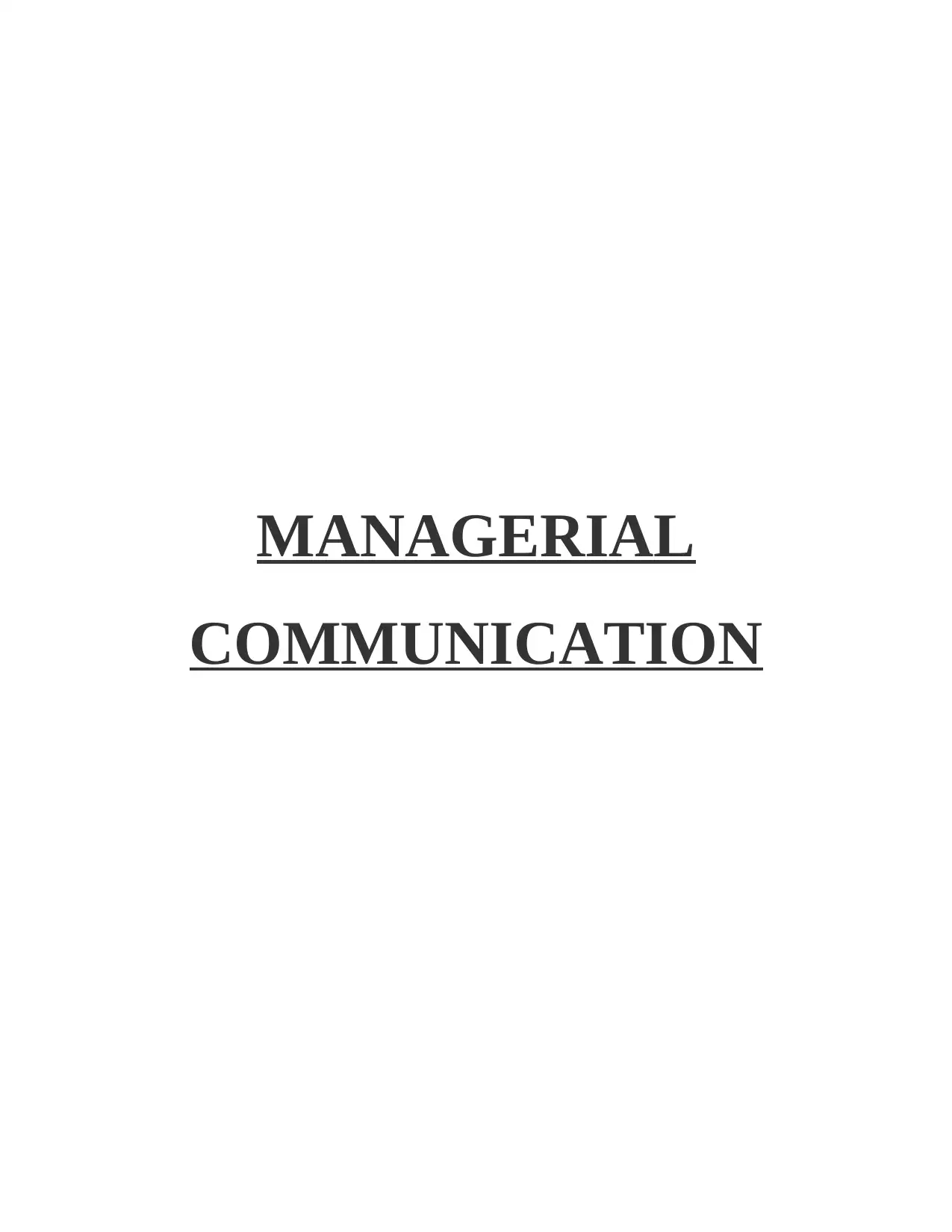
MANAGERIAL
COMMUNICATION
COMMUNICATION
Paraphrase This Document
Need a fresh take? Get an instant paraphrase of this document with our AI Paraphraser
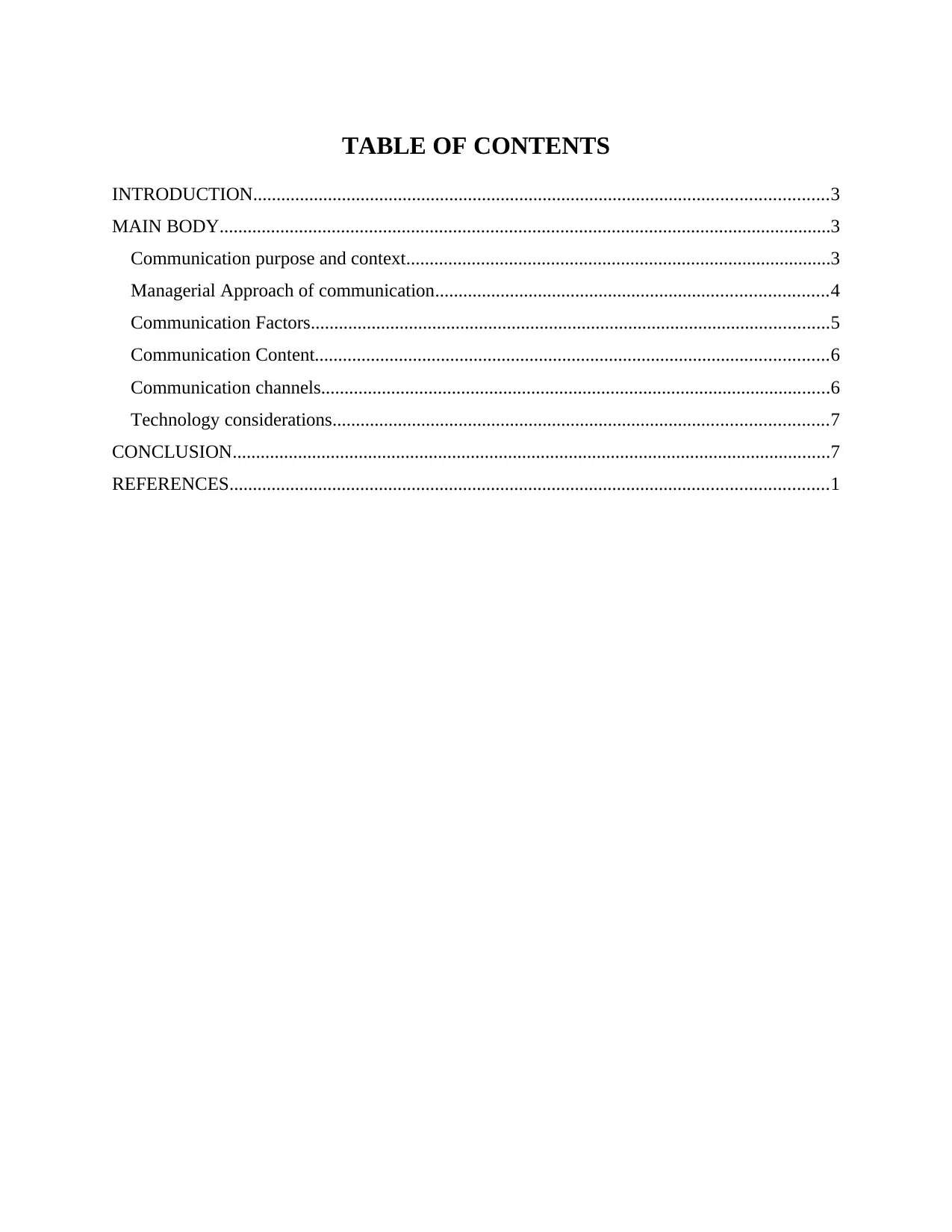
TABLE OF CONTENTS
INTRODUCTION...........................................................................................................................3
MAIN BODY...................................................................................................................................3
Communication purpose and context...........................................................................................3
Managerial Approach of communication....................................................................................4
Communication Factors...............................................................................................................5
Communication Content..............................................................................................................6
Communication channels.............................................................................................................6
Technology considerations..........................................................................................................7
CONCLUSION................................................................................................................................7
REFERENCES................................................................................................................................1
INTRODUCTION...........................................................................................................................3
MAIN BODY...................................................................................................................................3
Communication purpose and context...........................................................................................3
Managerial Approach of communication....................................................................................4
Communication Factors...............................................................................................................5
Communication Content..............................................................................................................6
Communication channels.............................................................................................................6
Technology considerations..........................................................................................................7
CONCLUSION................................................................................................................................7
REFERENCES................................................................................................................................1
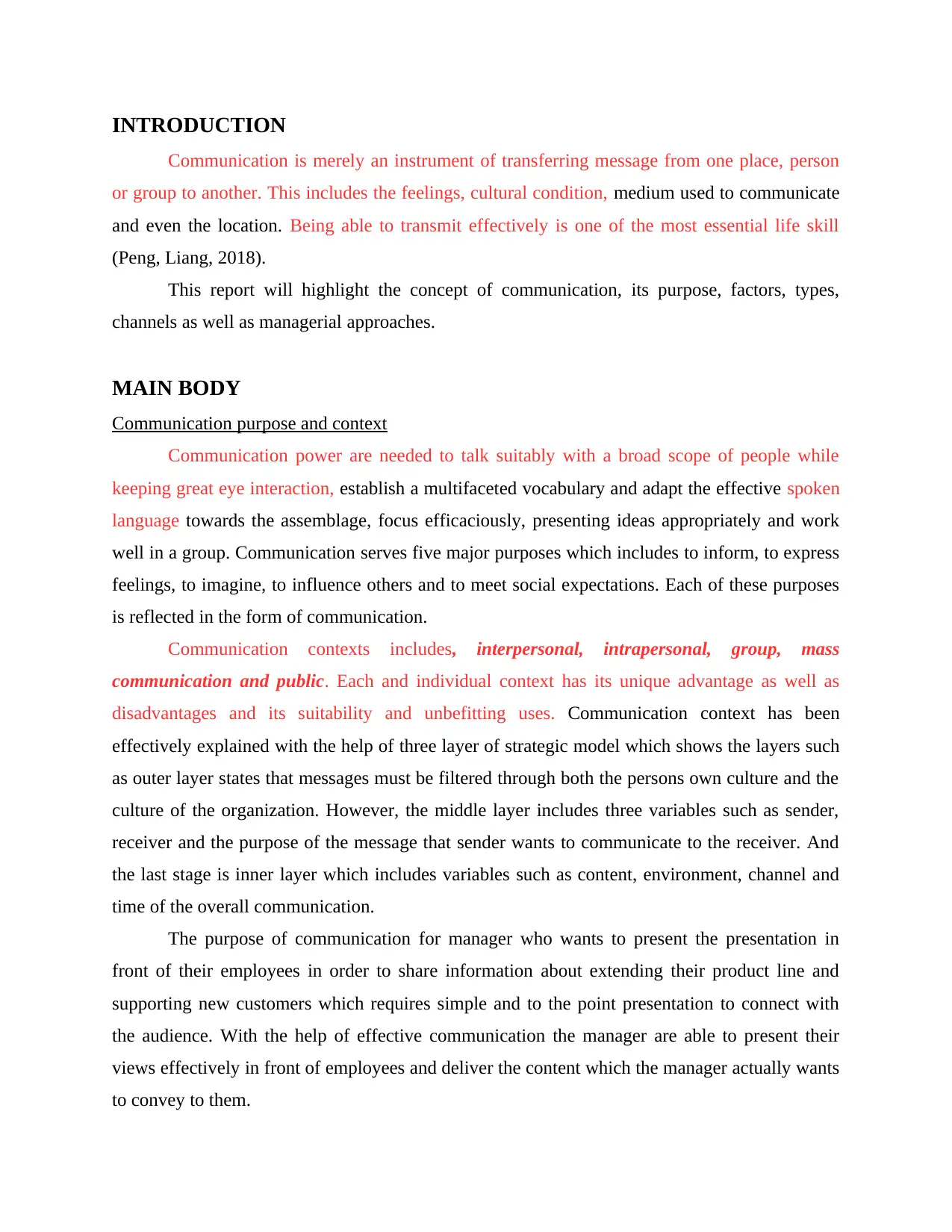
INTRODUCTION
Communication is merely an instrument of transferring message from one place, person
or group to another. This includes the feelings, cultural condition, medium used to communicate
and even the location. Being able to transmit effectively is one of the most essential life skill
(Peng, Liang, 2018).
This report will highlight the concept of communication, its purpose, factors, types,
channels as well as managerial approaches.
MAIN BODY
Communication purpose and context
Communication power are needed to talk suitably with a broad scope of people while
keeping great eye interaction, establish a multifaceted vocabulary and adapt the effective spoken
language towards the assemblage, focus efficaciously, presenting ideas appropriately and work
well in a group. Communication serves five major purposes which includes to inform, to express
feelings, to imagine, to influence others and to meet social expectations. Each of these purposes
is reflected in the form of communication.
Communication contexts includes, interpersonal, intrapersonal, group, mass
communication and public. Each and individual context has its unique advantage as well as
disadvantages and its suitability and unbefitting uses. Communication context has been
effectively explained with the help of three layer of strategic model which shows the layers such
as outer layer states that messages must be filtered through both the persons own culture and the
culture of the organization. However, the middle layer includes three variables such as sender,
receiver and the purpose of the message that sender wants to communicate to the receiver. And
the last stage is inner layer which includes variables such as content, environment, channel and
time of the overall communication.
The purpose of communication for manager who wants to present the presentation in
front of their employees in order to share information about extending their product line and
supporting new customers which requires simple and to the point presentation to connect with
the audience. With the help of effective communication the manager are able to present their
views effectively in front of employees and deliver the content which the manager actually wants
to convey to them.
Communication is merely an instrument of transferring message from one place, person
or group to another. This includes the feelings, cultural condition, medium used to communicate
and even the location. Being able to transmit effectively is one of the most essential life skill
(Peng, Liang, 2018).
This report will highlight the concept of communication, its purpose, factors, types,
channels as well as managerial approaches.
MAIN BODY
Communication purpose and context
Communication power are needed to talk suitably with a broad scope of people while
keeping great eye interaction, establish a multifaceted vocabulary and adapt the effective spoken
language towards the assemblage, focus efficaciously, presenting ideas appropriately and work
well in a group. Communication serves five major purposes which includes to inform, to express
feelings, to imagine, to influence others and to meet social expectations. Each of these purposes
is reflected in the form of communication.
Communication contexts includes, interpersonal, intrapersonal, group, mass
communication and public. Each and individual context has its unique advantage as well as
disadvantages and its suitability and unbefitting uses. Communication context has been
effectively explained with the help of three layer of strategic model which shows the layers such
as outer layer states that messages must be filtered through both the persons own culture and the
culture of the organization. However, the middle layer includes three variables such as sender,
receiver and the purpose of the message that sender wants to communicate to the receiver. And
the last stage is inner layer which includes variables such as content, environment, channel and
time of the overall communication.
The purpose of communication for manager who wants to present the presentation in
front of their employees in order to share information about extending their product line and
supporting new customers which requires simple and to the point presentation to connect with
the audience. With the help of effective communication the manager are able to present their
views effectively in front of employees and deliver the content which the manager actually wants
to convey to them.
⊘ This is a preview!⊘
Do you want full access?
Subscribe today to unlock all pages.

Trusted by 1+ million students worldwide
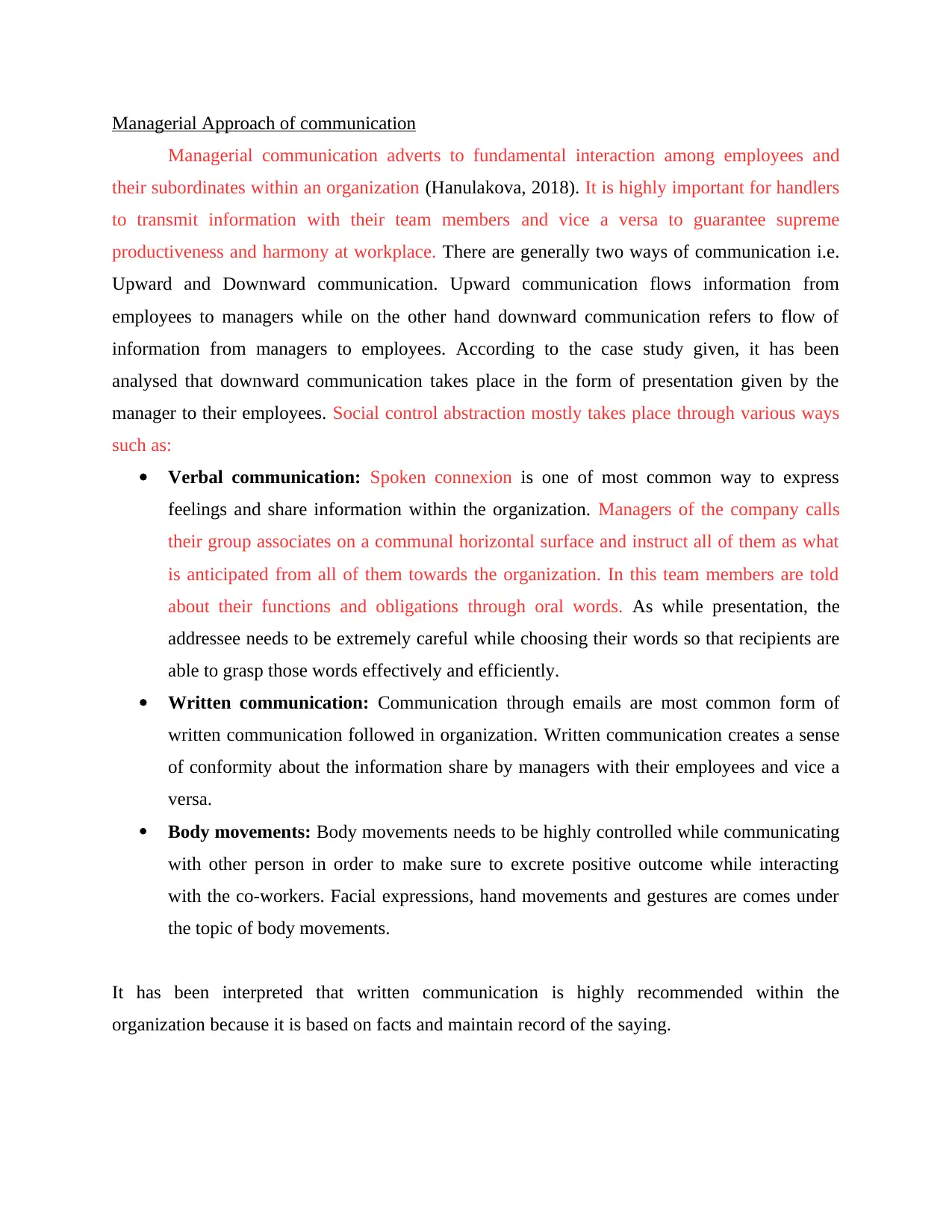
Managerial Approach of communication
Managerial communication adverts to fundamental interaction among employees and
their subordinates within an organization (Hanulakova, 2018). It is highly important for handlers
to transmit information with their team members and vice a versa to guarantee supreme
productiveness and harmony at workplace. There are generally two ways of communication i.e.
Upward and Downward communication. Upward communication flows information from
employees to managers while on the other hand downward communication refers to flow of
information from managers to employees. According to the case study given, it has been
analysed that downward communication takes place in the form of presentation given by the
manager to their employees. Social control abstraction mostly takes place through various ways
such as:
Verbal communication: Spoken connexion is one of most common way to express
feelings and share information within the organization. Managers of the company calls
their group associates on a communal horizontal surface and instruct all of them as what
is anticipated from all of them towards the organization. In this team members are told
about their functions and obligations through oral words. As while presentation, the
addressee needs to be extremely careful while choosing their words so that recipients are
able to grasp those words effectively and efficiently.
Written communication: Communication through emails are most common form of
written communication followed in organization. Written communication creates a sense
of conformity about the information share by managers with their employees and vice a
versa.
Body movements: Body movements needs to be highly controlled while communicating
with other person in order to make sure to excrete positive outcome while interacting
with the co-workers. Facial expressions, hand movements and gestures are comes under
the topic of body movements.
It has been interpreted that written communication is highly recommended within the
organization because it is based on facts and maintain record of the saying.
Managerial communication adverts to fundamental interaction among employees and
their subordinates within an organization (Hanulakova, 2018). It is highly important for handlers
to transmit information with their team members and vice a versa to guarantee supreme
productiveness and harmony at workplace. There are generally two ways of communication i.e.
Upward and Downward communication. Upward communication flows information from
employees to managers while on the other hand downward communication refers to flow of
information from managers to employees. According to the case study given, it has been
analysed that downward communication takes place in the form of presentation given by the
manager to their employees. Social control abstraction mostly takes place through various ways
such as:
Verbal communication: Spoken connexion is one of most common way to express
feelings and share information within the organization. Managers of the company calls
their group associates on a communal horizontal surface and instruct all of them as what
is anticipated from all of them towards the organization. In this team members are told
about their functions and obligations through oral words. As while presentation, the
addressee needs to be extremely careful while choosing their words so that recipients are
able to grasp those words effectively and efficiently.
Written communication: Communication through emails are most common form of
written communication followed in organization. Written communication creates a sense
of conformity about the information share by managers with their employees and vice a
versa.
Body movements: Body movements needs to be highly controlled while communicating
with other person in order to make sure to excrete positive outcome while interacting
with the co-workers. Facial expressions, hand movements and gestures are comes under
the topic of body movements.
It has been interpreted that written communication is highly recommended within the
organization because it is based on facts and maintain record of the saying.
Paraphrase This Document
Need a fresh take? Get an instant paraphrase of this document with our AI Paraphraser
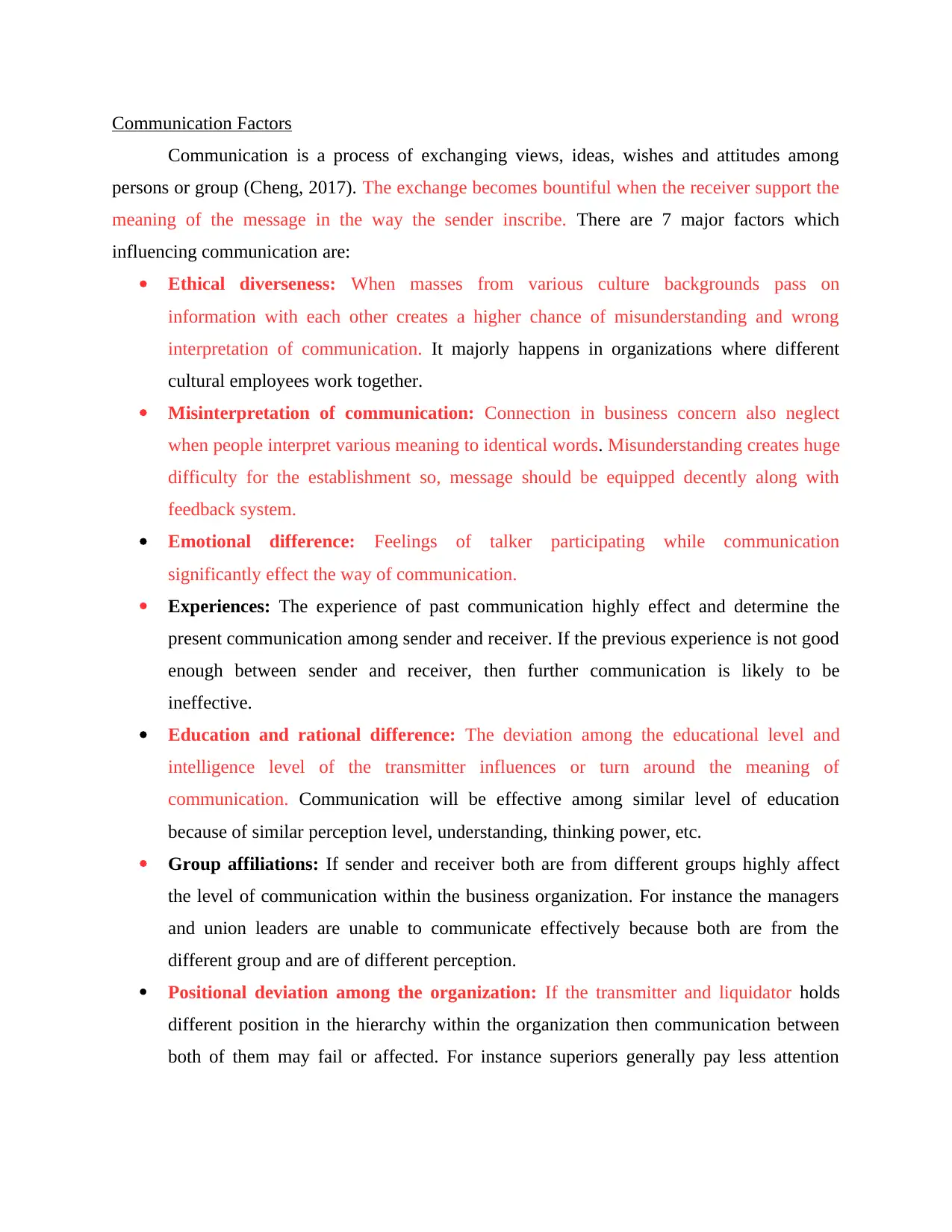
Communication Factors
Communication is a process of exchanging views, ideas, wishes and attitudes among
persons or group (Cheng, 2017). The exchange becomes bountiful when the receiver support the
meaning of the message in the way the sender inscribe. There are 7 major factors which
influencing communication are:
Ethical diverseness: When masses from various culture backgrounds pass on
information with each other creates a higher chance of misunderstanding and wrong
interpretation of communication. It majorly happens in organizations where different
cultural employees work together.
Misinterpretation of communication: Connection in business concern also neglect
when people interpret various meaning to identical words. Misunderstanding creates huge
difficulty for the establishment so, message should be equipped decently along with
feedback system.
Emotional difference: Feelings of talker participating while communication
significantly effect the way of communication.
Experiences: The experience of past communication highly effect and determine the
present communication among sender and receiver. If the previous experience is not good
enough between sender and receiver, then further communication is likely to be
ineffective.
Education and rational difference: The deviation among the educational level and
intelligence level of the transmitter influences or turn around the meaning of
communication. Communication will be effective among similar level of education
because of similar perception level, understanding, thinking power, etc.
Group affiliations: If sender and receiver both are from different groups highly affect
the level of communication within the business organization. For instance the managers
and union leaders are unable to communicate effectively because both are from the
different group and are of different perception.
Positional deviation among the organization: If the transmitter and liquidator holds
different position in the hierarchy within the organization then communication between
both of them may fail or affected. For instance superiors generally pay less attention
Communication is a process of exchanging views, ideas, wishes and attitudes among
persons or group (Cheng, 2017). The exchange becomes bountiful when the receiver support the
meaning of the message in the way the sender inscribe. There are 7 major factors which
influencing communication are:
Ethical diverseness: When masses from various culture backgrounds pass on
information with each other creates a higher chance of misunderstanding and wrong
interpretation of communication. It majorly happens in organizations where different
cultural employees work together.
Misinterpretation of communication: Connection in business concern also neglect
when people interpret various meaning to identical words. Misunderstanding creates huge
difficulty for the establishment so, message should be equipped decently along with
feedback system.
Emotional difference: Feelings of talker participating while communication
significantly effect the way of communication.
Experiences: The experience of past communication highly effect and determine the
present communication among sender and receiver. If the previous experience is not good
enough between sender and receiver, then further communication is likely to be
ineffective.
Education and rational difference: The deviation among the educational level and
intelligence level of the transmitter influences or turn around the meaning of
communication. Communication will be effective among similar level of education
because of similar perception level, understanding, thinking power, etc.
Group affiliations: If sender and receiver both are from different groups highly affect
the level of communication within the business organization. For instance the managers
and union leaders are unable to communicate effectively because both are from the
different group and are of different perception.
Positional deviation among the organization: If the transmitter and liquidator holds
different position in the hierarchy within the organization then communication between
both of them may fail or affected. For instance superiors generally pay less attention
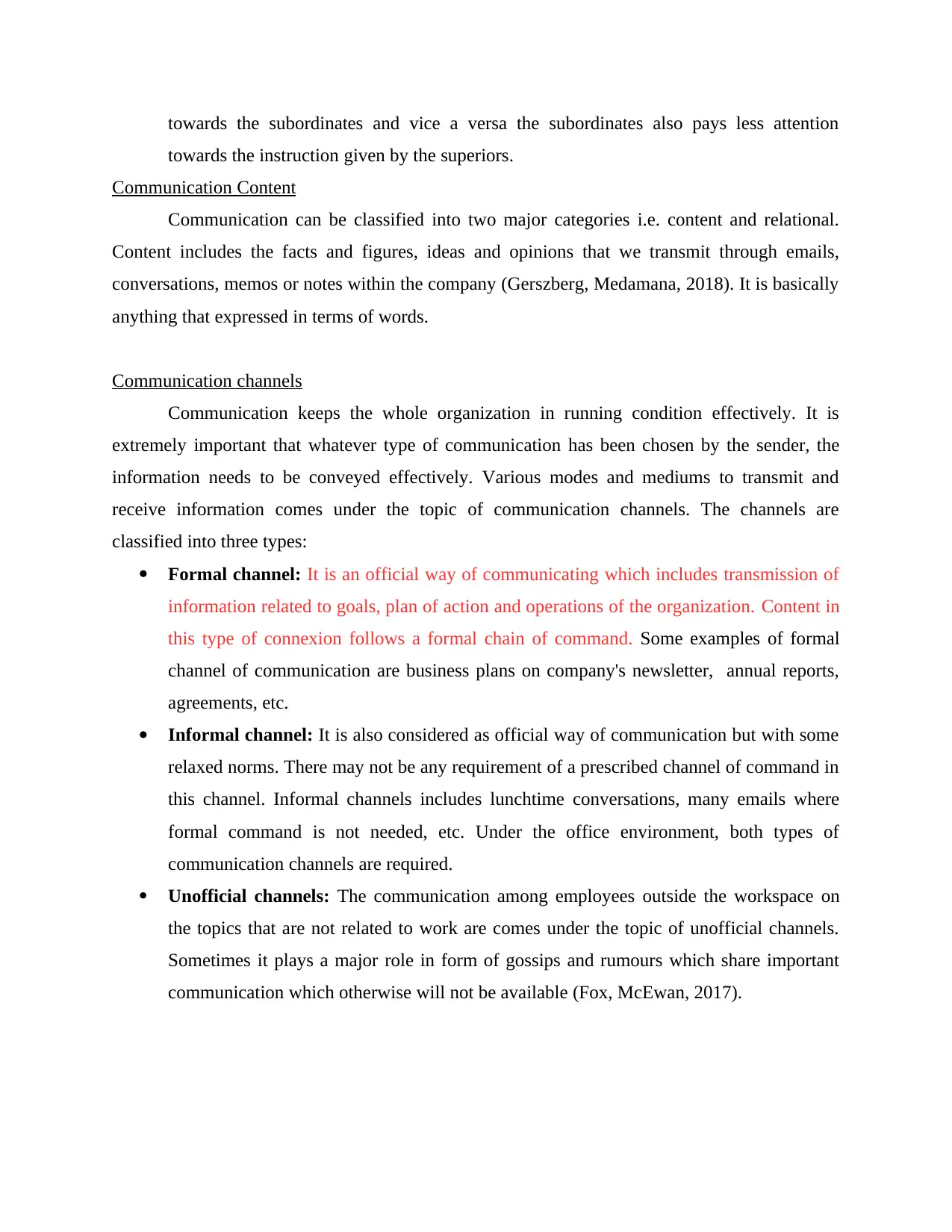
towards the subordinates and vice a versa the subordinates also pays less attention
towards the instruction given by the superiors.
Communication Content
Communication can be classified into two major categories i.e. content and relational.
Content includes the facts and figures, ideas and opinions that we transmit through emails,
conversations, memos or notes within the company (Gerszberg, Medamana, 2018). It is basically
anything that expressed in terms of words.
Communication channels
Communication keeps the whole organization in running condition effectively. It is
extremely important that whatever type of communication has been chosen by the sender, the
information needs to be conveyed effectively. Various modes and mediums to transmit and
receive information comes under the topic of communication channels. The channels are
classified into three types:
Formal channel: It is an official way of communicating which includes transmission of
information related to goals, plan of action and operations of the organization. Content in
this type of connexion follows a formal chain of command. Some examples of formal
channel of communication are business plans on company's newsletter, annual reports,
agreements, etc.
Informal channel: It is also considered as official way of communication but with some
relaxed norms. There may not be any requirement of a prescribed channel of command in
this channel. Informal channels includes lunchtime conversations, many emails where
formal command is not needed, etc. Under the office environment, both types of
communication channels are required.
Unofficial channels: The communication among employees outside the workspace on
the topics that are not related to work are comes under the topic of unofficial channels.
Sometimes it plays a major role in form of gossips and rumours which share important
communication which otherwise will not be available (Fox, McEwan, 2017).
towards the instruction given by the superiors.
Communication Content
Communication can be classified into two major categories i.e. content and relational.
Content includes the facts and figures, ideas and opinions that we transmit through emails,
conversations, memos or notes within the company (Gerszberg, Medamana, 2018). It is basically
anything that expressed in terms of words.
Communication channels
Communication keeps the whole organization in running condition effectively. It is
extremely important that whatever type of communication has been chosen by the sender, the
information needs to be conveyed effectively. Various modes and mediums to transmit and
receive information comes under the topic of communication channels. The channels are
classified into three types:
Formal channel: It is an official way of communicating which includes transmission of
information related to goals, plan of action and operations of the organization. Content in
this type of connexion follows a formal chain of command. Some examples of formal
channel of communication are business plans on company's newsletter, annual reports,
agreements, etc.
Informal channel: It is also considered as official way of communication but with some
relaxed norms. There may not be any requirement of a prescribed channel of command in
this channel. Informal channels includes lunchtime conversations, many emails where
formal command is not needed, etc. Under the office environment, both types of
communication channels are required.
Unofficial channels: The communication among employees outside the workspace on
the topics that are not related to work are comes under the topic of unofficial channels.
Sometimes it plays a major role in form of gossips and rumours which share important
communication which otherwise will not be available (Fox, McEwan, 2017).
⊘ This is a preview!⊘
Do you want full access?
Subscribe today to unlock all pages.

Trusted by 1+ million students worldwide
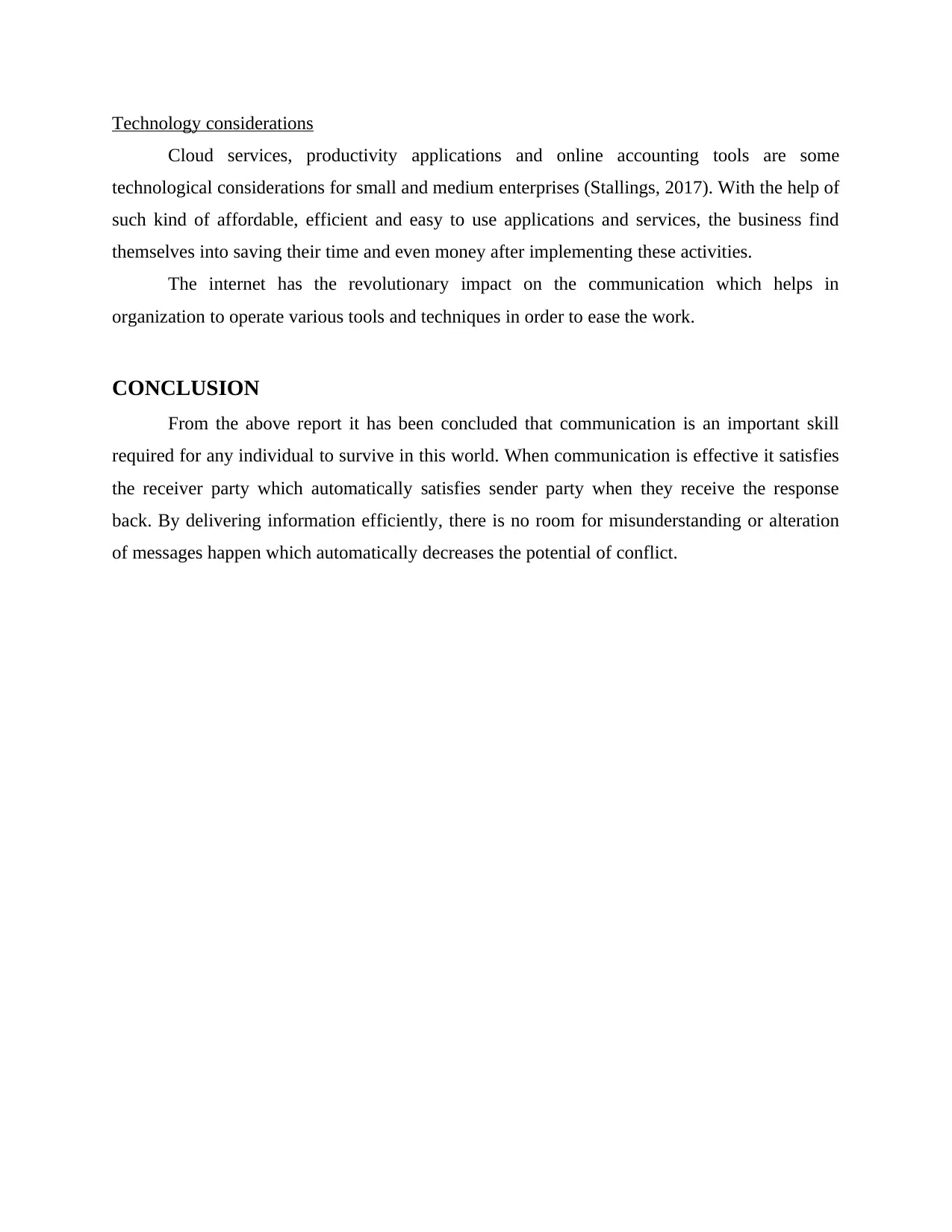
Technology considerations
Cloud services, productivity applications and online accounting tools are some
technological considerations for small and medium enterprises (Stallings, 2017). With the help of
such kind of affordable, efficient and easy to use applications and services, the business find
themselves into saving their time and even money after implementing these activities.
The internet has the revolutionary impact on the communication which helps in
organization to operate various tools and techniques in order to ease the work.
CONCLUSION
From the above report it has been concluded that communication is an important skill
required for any individual to survive in this world. When communication is effective it satisfies
the receiver party which automatically satisfies sender party when they receive the response
back. By delivering information efficiently, there is no room for misunderstanding or alteration
of messages happen which automatically decreases the potential of conflict.
Cloud services, productivity applications and online accounting tools are some
technological considerations for small and medium enterprises (Stallings, 2017). With the help of
such kind of affordable, efficient and easy to use applications and services, the business find
themselves into saving their time and even money after implementing these activities.
The internet has the revolutionary impact on the communication which helps in
organization to operate various tools and techniques in order to ease the work.
CONCLUSION
From the above report it has been concluded that communication is an important skill
required for any individual to survive in this world. When communication is effective it satisfies
the receiver party which automatically satisfies sender party when they receive the response
back. By delivering information efficiently, there is no room for misunderstanding or alteration
of messages happen which automatically decreases the potential of conflict.
Paraphrase This Document
Need a fresh take? Get an instant paraphrase of this document with our AI Paraphraser
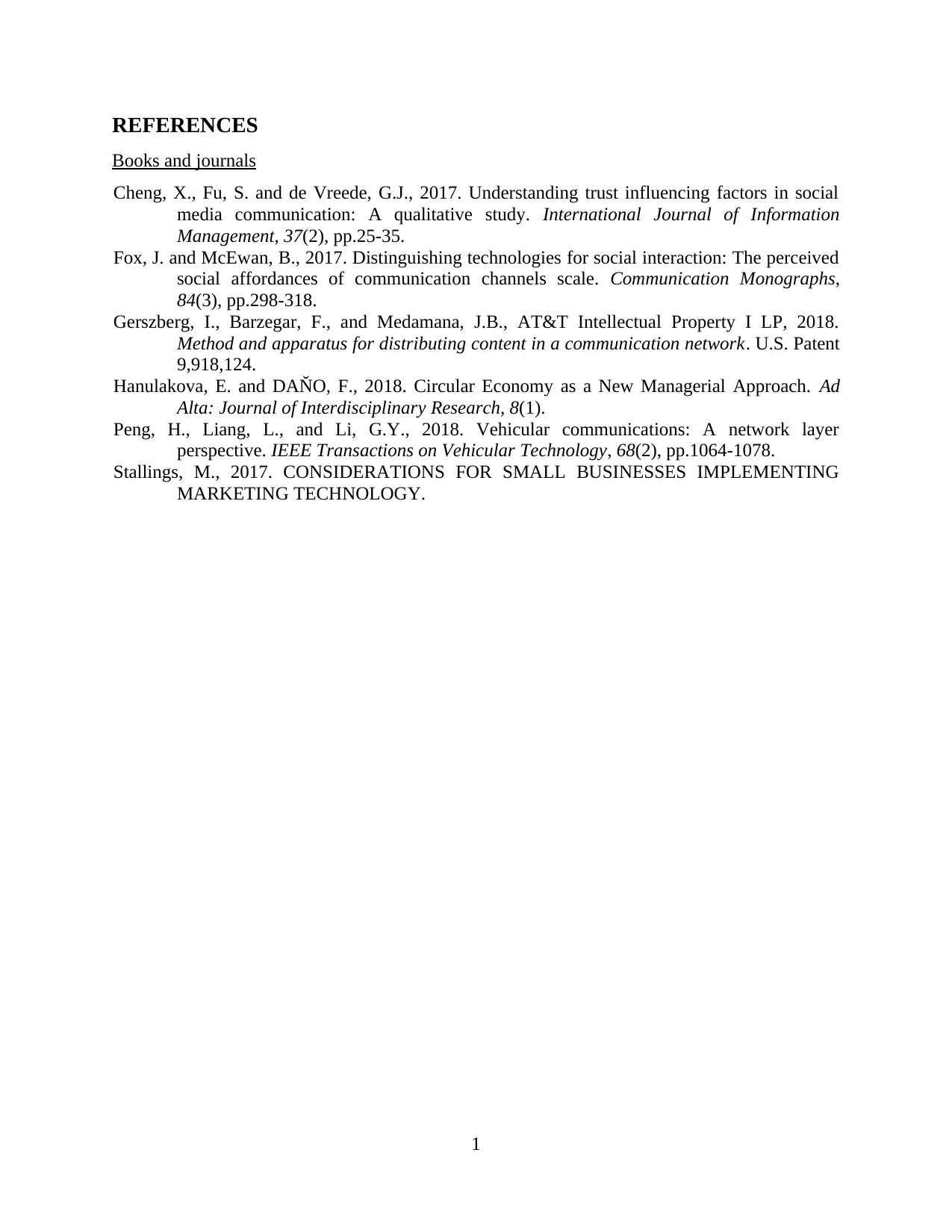
REFERENCES
Books and journals
Cheng, X., Fu, S. and de Vreede, G.J., 2017. Understanding trust influencing factors in social
media communication: A qualitative study. International Journal of Information
Management, 37(2), pp.25-35.
Fox, J. and McEwan, B., 2017. Distinguishing technologies for social interaction: The perceived
social affordances of communication channels scale. Communication Monographs,
84(3), pp.298-318.
Gerszberg, I., Barzegar, F., and Medamana, J.B., AT&T Intellectual Property I LP, 2018.
Method and apparatus for distributing content in a communication network. U.S. Patent
9,918,124.
Hanulakova, E. and DAŇO, F., 2018. Circular Economy as a New Managerial Approach. Ad
Alta: Journal of Interdisciplinary Research, 8(1).
Peng, H., Liang, L., and Li, G.Y., 2018. Vehicular communications: A network layer
perspective. IEEE Transactions on Vehicular Technology, 68(2), pp.1064-1078.
Stallings, M., 2017. CONSIDERATIONS FOR SMALL BUSINESSES IMPLEMENTING
MARKETING TECHNOLOGY.
1
Books and journals
Cheng, X., Fu, S. and de Vreede, G.J., 2017. Understanding trust influencing factors in social
media communication: A qualitative study. International Journal of Information
Management, 37(2), pp.25-35.
Fox, J. and McEwan, B., 2017. Distinguishing technologies for social interaction: The perceived
social affordances of communication channels scale. Communication Monographs,
84(3), pp.298-318.
Gerszberg, I., Barzegar, F., and Medamana, J.B., AT&T Intellectual Property I LP, 2018.
Method and apparatus for distributing content in a communication network. U.S. Patent
9,918,124.
Hanulakova, E. and DAŇO, F., 2018. Circular Economy as a New Managerial Approach. Ad
Alta: Journal of Interdisciplinary Research, 8(1).
Peng, H., Liang, L., and Li, G.Y., 2018. Vehicular communications: A network layer
perspective. IEEE Transactions on Vehicular Technology, 68(2), pp.1064-1078.
Stallings, M., 2017. CONSIDERATIONS FOR SMALL BUSINESSES IMPLEMENTING
MARKETING TECHNOLOGY.
1
1 out of 8
Related Documents
Your All-in-One AI-Powered Toolkit for Academic Success.
+13062052269
info@desklib.com
Available 24*7 on WhatsApp / Email
![[object Object]](/_next/static/media/star-bottom.7253800d.svg)
Unlock your academic potential
Copyright © 2020–2025 A2Z Services. All Rights Reserved. Developed and managed by ZUCOL.




